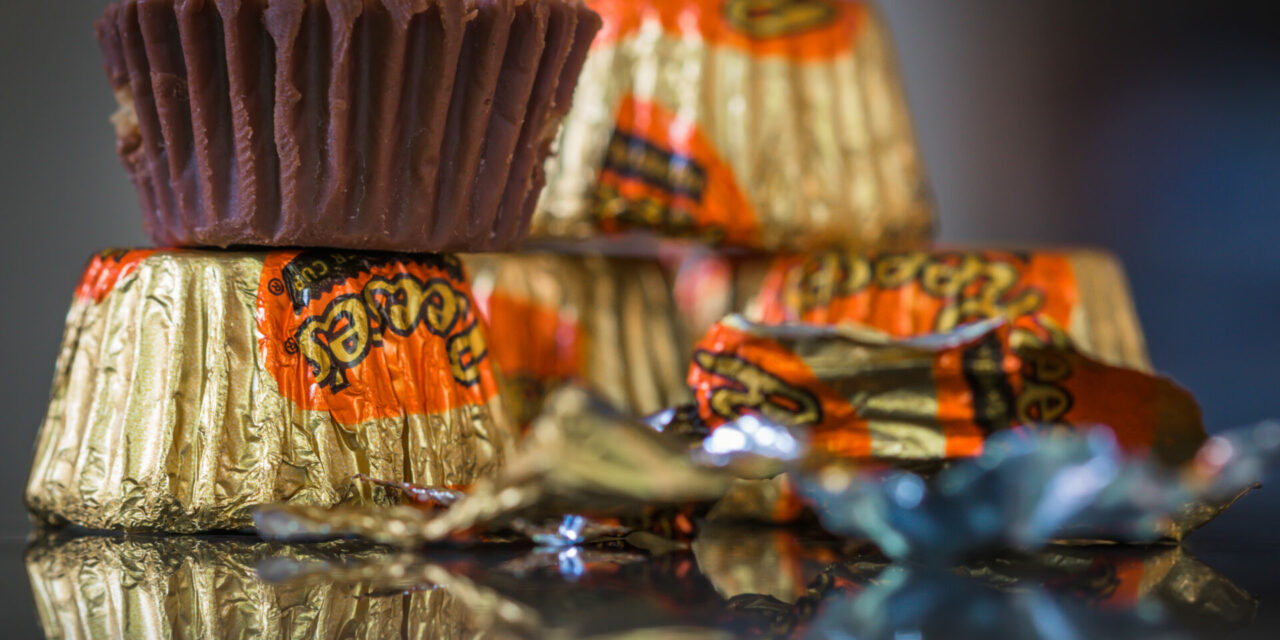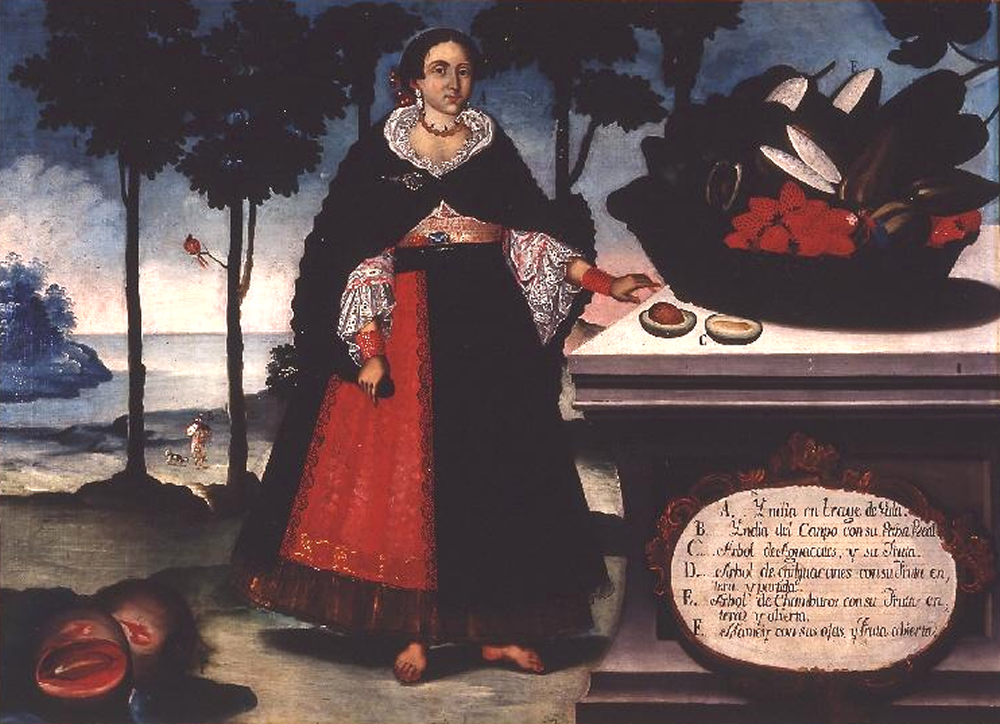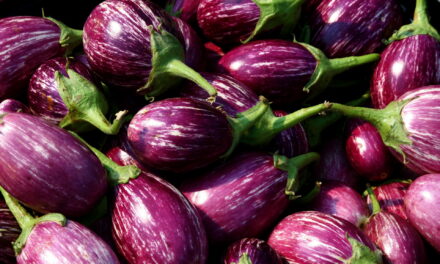A Morsel, by Ravi Shah (CC BY 2.0.)
The Peanut Butter Epiphanies
On November 15, 1928, a dairy farmer by the name of H.B. Reese filled a chocolate cup with peanut butter, and the greatest confectionary of all time was born. The Reese’s Peanut Butter Cup, known then as the Penny Cup, cost one cent. The simply delectable cupcake truffle married peanut butter, chocolate, and sugar and still tops the candy selling charts nearly a century later. The Reese’s cup has had endless incarnations, from bite size miniatures to half a pounders, and filled with caramel, marshmallow, honey roasted nuts, white crème, fudge, and bananas. But the most loved is the classic- one cannot improve upon perfection, after all.
Chocolate was then and is now one of the culinary wonders of the world, and pairing it with peanut butter was a stroke of genius. It was entirely dependent, of course, on peanut butter having been invented in the first place. Without that nutty, melt-in-your-mouth magic of peanut butter, the Penny Cup would have been just another chocolate candy option, not match made in heaven that makes the candy fave lists across countries to this day.
Just that year, the smooth peanut butter dreamed up by chemist Joseph Rosefield in 1922 was licensed as Peter Pan. Joe Rosefield would be the Skippy king, too, perfecting a smoothing process first, and then later adding crunch back in for chunky style. Rosefield filed a patent for partial hydrogenation to peanut butter, a process used to stabilize the oils and keep them blended rather than separated.
Rosefield solved a peanut butter problem: how to avoid the separation of the oil from the paste during shelf life and transportation. But the storage solution was not really the invention of peanut butter. The stuff had already been invented, a few times over, by that date.
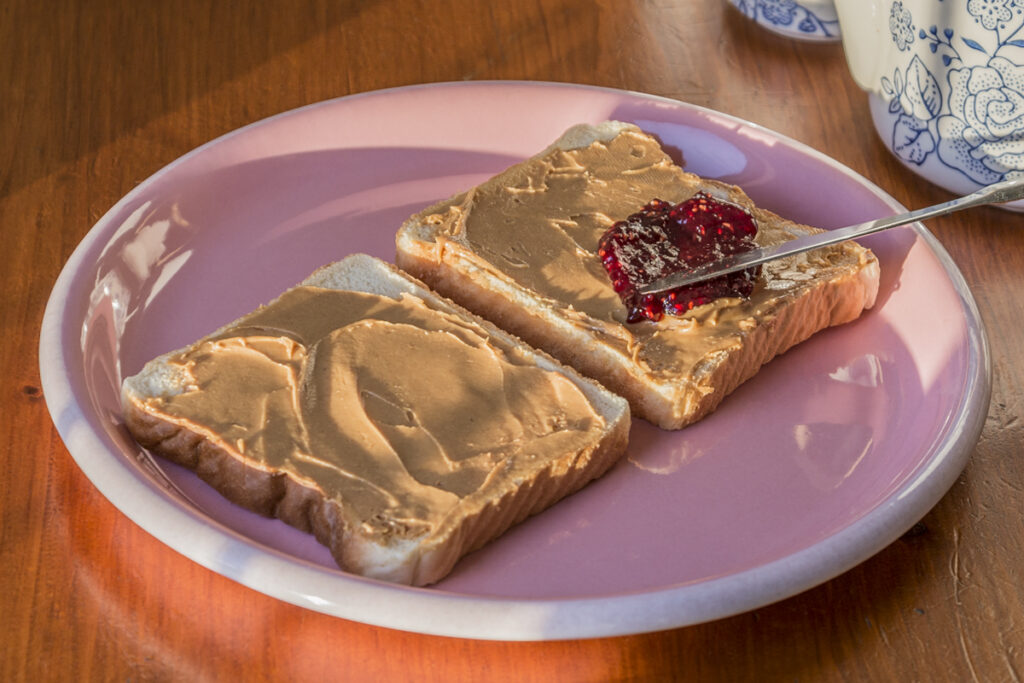
photo by Matias Garabedian from Montreal, Canada, CC BY-SA 2.0 via Wikimedia Commons
Canada’s own Marcellus Gilmore Edson of Montreal is credited by the US National Peanut Board as the first patent for producing peanut butter from roasted peanuts using heated surfaces. That was decades past already, in 1884. Edson’s patent described the stuff as having a “consistency like butter, lard, or ointment.” An American businessman a decade on, George Bayle, sold peanut butter as a snack food product. John Harvey Kellogg, of cereal fame, is the guy usually credited with peanut butter’s invention. He was solving a problem too. Patients at Kellogg’s Western Health Reform Institute who were not able to chew protein rich foods needed a meal replacement. Although, as we shall see, peanuts had a long history being viewed as peasant food, or food for field hands, suddenly the boiled peanut paste was a luxury item for the old and the rich.
Kellogg rejoiced at the peanut paste solution and trumpeted his delicacy as a wholesome and healthy alternative for the more salacious animal proteins. He would later to be hawking Bran Flakes and Corn Flakes as part of his “natural hygiene” plan, a regimen that sounded vaguely benign and healthy, but was actually about cleansing more than just your colon. Kellogg was fixated on plant-based nutrition and bulking up the bowels for elimination. He believed replacing animal foods would make you healthier because you would be, well, cleaner. Kellogg’s fixation on constipation was connected to his conviction that meat proteins inspired immoral lusts. Beef and bulging bowels both led to impure thoughts and frantic self-pleasuring sessions behind the barn, for young and old alike. Without such a purifying protocol, his recommendations ranged from pinning baby bits to the nappy, washing little girls with carbolic acid, and warnings of blindness and hairy palms. In such a frame of mind, peanut pablum was a victory over unruly passions.
Most people do not think of the grandfather of Frosted Flakes or the Skippy chemist when thinking about their breakfast bagel with PB and J. If you were on a game show, and asked who invented peanut butter, who would you name?
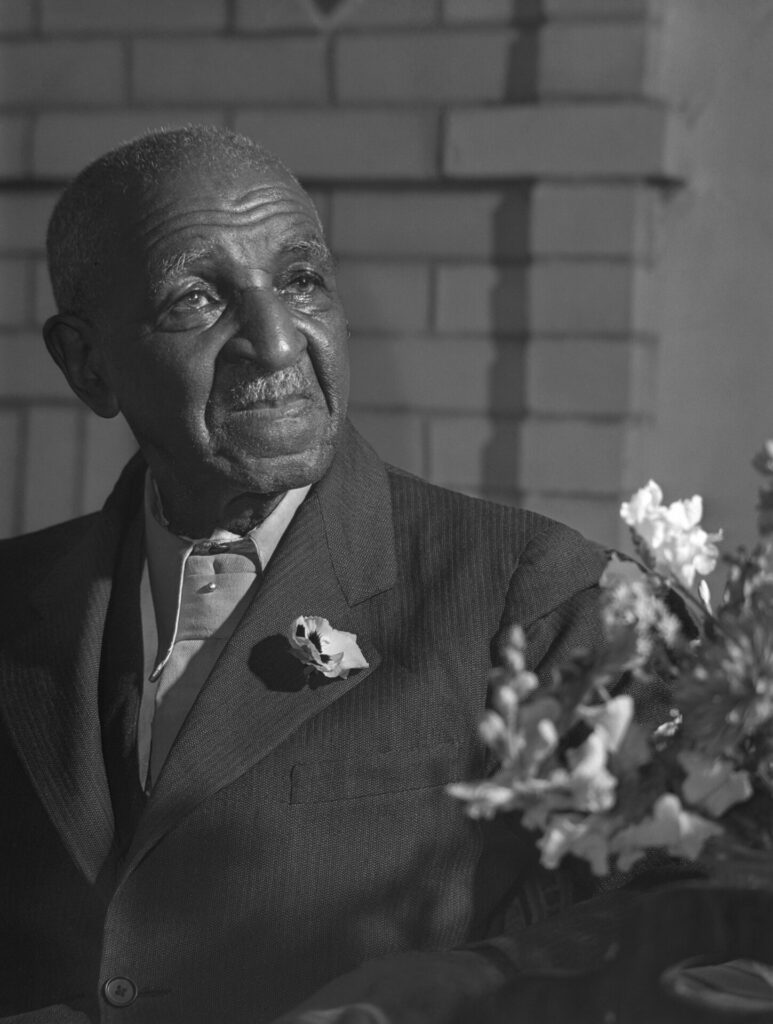
George Washington Carver, photo by Arthur Rothstein, Public domain, via Wikimedia Commons
My guess is that you said George Washington Carver. The vast majority of us think George Washington Carver invented peanut butter.
This could because we attended a party with Elaine Benes in Season 3 of Seinfeld, where an annoying and enthusiastic Carver supporter tries to impress a restless, distracted Elaine. While she pats her head using a secret rescue signal for Jerry, he waxes rhapsodic over Carter.
“On the other hand, you take a guy like George Washington Carver. The man devoted his whole life to the peanut. Imagine having so much passion for something…Peanut brittle, peanut butter, peanut oil…”
Even if you have better things to do than watch Jerry reruns, chances are Carver’s your guess, too. And a good guess it is. Carver is synonymous with peanuts. The African-American Tuskegee professor and agricultural scientist was born into slavery in Missouri just before the evil institution dissolved. As an infant, he and his siblings were kidnapped by racist raiders and sold. His owner, Moses Carver, bought him back, then raised him as his own child after the abolition. Moses and his wife taught George to read when schools refused to do so. Carver loved to draw flowers and landscapes, and he became a Black visual artist when there were few known. He was a Black scientist when there were even fewer. Carver was a renowned environmentalist and agriculturalist and concerned with the ways cotton depleted the soils. He also wanted impoverished farmers, especially Black people, to be able to provide for themselves and their families. He was a big believer in the peanut, which was a sustainable crop and promoted sustainable nutrition. Carver found more than 300 uses for peanuts, from peanut meatloaf to topical venereal disease ointment to shaving cream. The man was a genius, so much so that Time Magazine called him the “Black Leonardo” on a 1941 cover story. But he did not invent peanut butter.
The thing is, though, he may as well have. The patent machines and the sanitarium pap recipes did not really peanut butter make, after all. Peanuts make peanut butter, and who advertised it first, or devised a device, or sold it in what context really matters very little. It’s the peanut itself that matters for peanut butter. And so Carver crushed peanuts into paste for hair gel and pasta. And Kellogg made sure his sickly patients weren’t sneaking behind their mobility devices for a little circulation therapy. And African-Americans before Carver was born were making peanut butter soup just like they had back home before they were ripped from their lands. And long before that, we have to go back to Mexico, and Bolivia, and Peru, and Brazil.
The peanut, or Arachis hypogaea, is not a nut but a legume. Its subterranean pod is a carapace with the texture of a basket, and inside its pod are one, three, or usually two small crunchy “nuts.” Peanuts are sometimes known around the world as “goobers” or goober nuts, or more commonly, “groundnuts.”
While peanuts were cruelly considered food only for slaves and livestock for much of American history, Carver and Kellogg’s respective endorsements helped raise the profile across diverse communities. Despite various challenges such as toxic hydrogenation, severe allergies, and deadly molds, for the most part, peanuts and peanut butter pack a hearty nutritious punch. A few spoons of nuts or spread adds a whopping range of 25 to 90% of the recommended daily intake of thiamine, riboflavin, niacin, folate, vitamin E, magnesium, manganese, phosphorus and zinc. Peanuts also contain all the essential amino acids, and a range of fats.
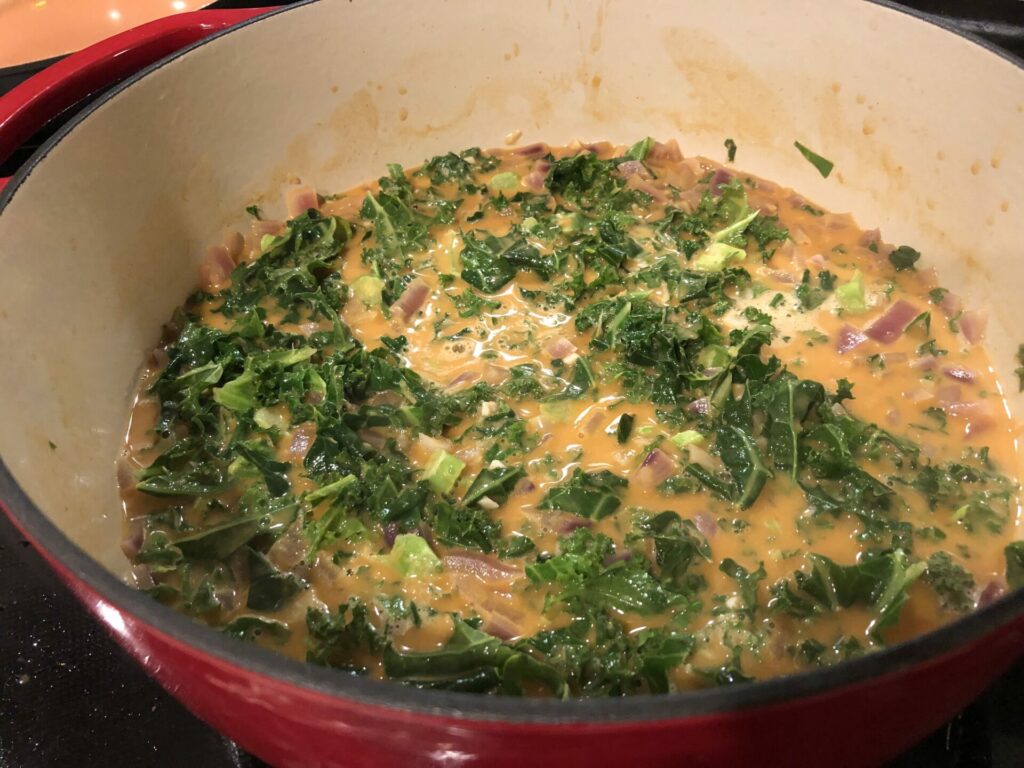
African Peanut Soup, photo by Wesley Fryer, CC BY 2.0 via Wikimedia Commons
Though peanuts grew in the States, moving naturally northward from their origin in Latin America, most of the US crops originate in Africa, where groundnut stew was beloved in countless incarnations. African peanut soup could be bubbling with fragrant spices and birds; it could be thick with various greens and roots.
If we are unlucky and unfamiliar with the bountiful bombast of African soups, most of our mouths water when we ponder peanut sauce, something we associate with Asian cooking, especially Thai. Crushed peanuts of peanut paste is more or less peanut butter by another name, and pretending otherwise is dishonest. Everyone I know orders extra peanut sauce, sometimes just called “satay sauce,” with Thai takeout. It’s made of peanuts, coconut milk, tomatoes, peppers, and spices, and heaped onto meats and noodles. Surely Asian cultures have been simmering this for centuries?
Well, yes, but barely. Thai satay “peanut butter” is not an ancient secret. Variations of peanut sauce recipes developed throughout South Asia in the 17th centuries, becoming wildly popular in Indonesian are and moving to Thailand and China and beyond. The peanut came from “the New World,” with Dutch, Spanish and Portuguese colonists- some as slave traders, some as merchants. The traders brought them from Latin America, where peanut butter was really born.
We don’t know the exact origin story of the peanut or of peanut butter, even if we can and should have birthday parties for Reese’s Peanut Butter Cups. But we know it’s an old, old, old story near mountains and rainforests. We can trace a peanut plant relative to 7600 years, found in Peru. The Moche, people indigenous to the region, depicted peanuts in their art, and other local cultures, the Incas, included peanuts as sacrificial offerings. Unsurprisingly, Peru has many traditional and Spanish-fusion dishes featuring peanuts. Ocopa is a peanut sauce with local chiles. Guinea pigs roasted with peanuts are an ancient delight.
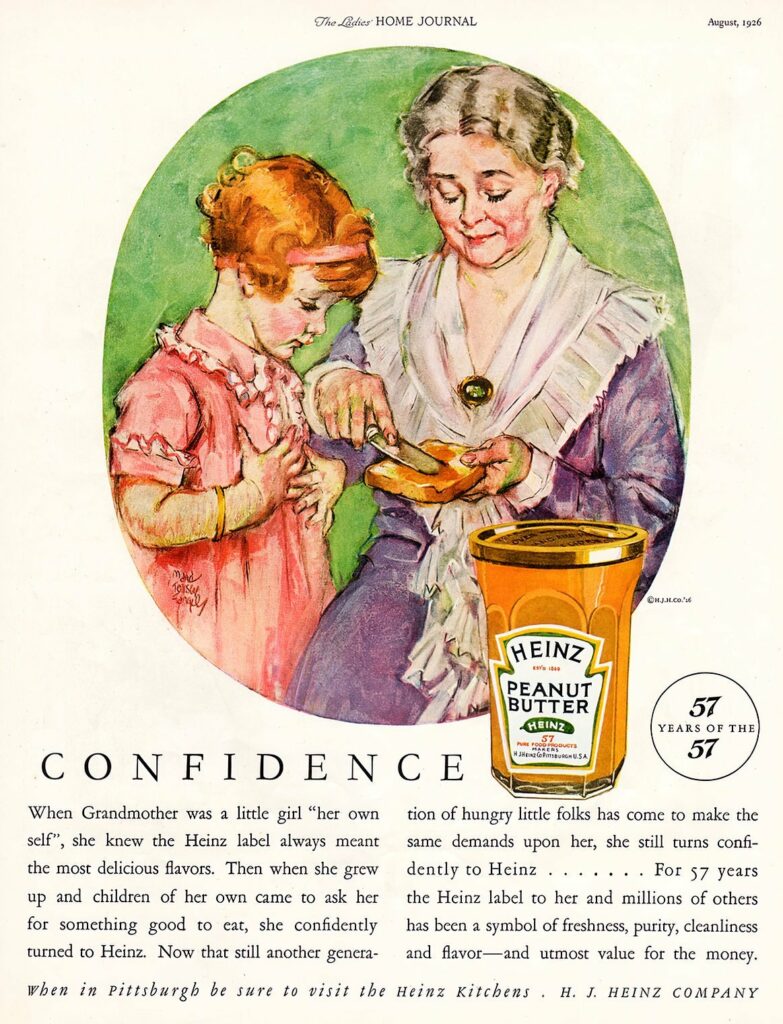
1920s Peanut Butter Ad
Indigenous people in Brazil made a peanut sauce to combine with corn, liquifying them into a nourishing beverage. And Bolivia is famous for its ancient chicken and peanut soup, long predating the delicious peanut soups of Africa. Bolivian sopa de mani is traditionally served with peas and chicken.
In Mexico, delicious peanut dishes including ground up paste sauces were long part of the markets and the menus by the time the Spaniards arrived. Encacahuatado was a peanut sauce with chicken, versions of which ultimately made their way around the world.
All of these savoury sensations in every corner of the globe elevate the peanut to culinary superstore. But that doesn’t change the fact that peanut butter glory is also a sweeter story. There’s a reason we slather jam on the classic peanut butter and bread affair. There’s another treasure trove of lore for peanut brittle, an intense and irresistible peanut dessert that might be Irish and might be southern. Or from Ghana- nkate is a peanut sweet similar to brittle.
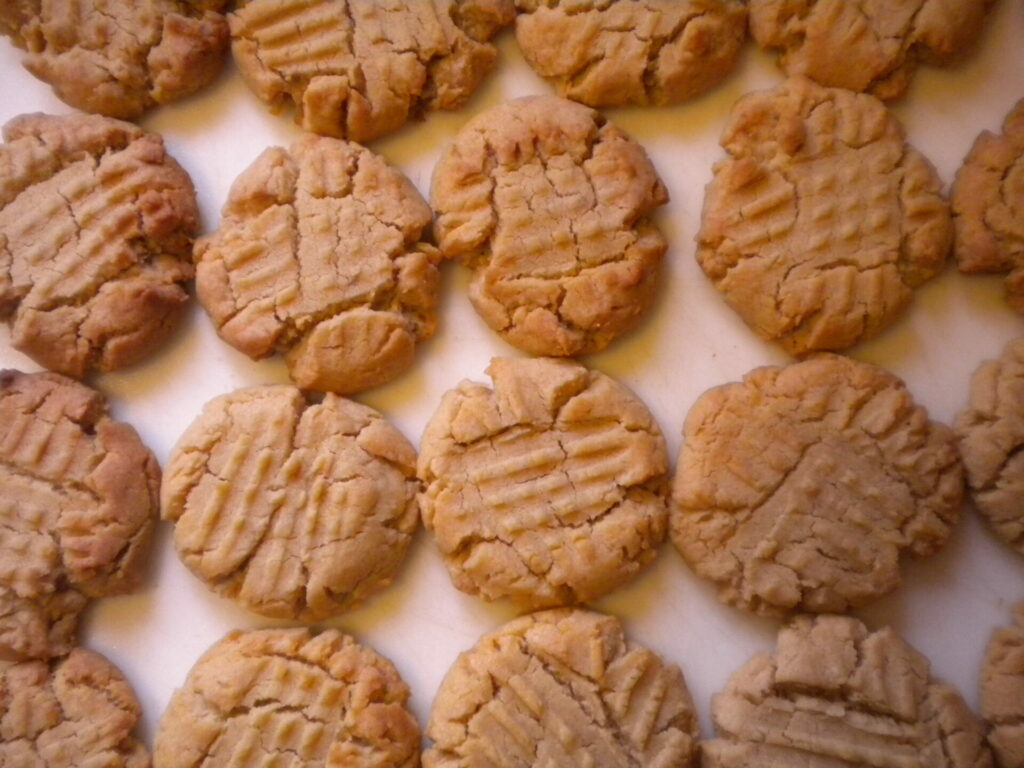
Peanut Butter Cookies, photo by Denise Krebs (CC BY 2.0)
Speaking of southern, you know all about pecan pie, but peanut pie is a thing- an even better thing, some would argue. And peanut butter cookies are one of the simplest and most profound pleasures on planet earth. The first known recipe for these yummies was in George Washington Carver’s Tuskegee Institute cookbook.
But then, but then, wedding bells, the slow dance of chocolate with creamy peanuts. The ultimate peanut dessert. You can have your own Penny Cups at home for a few bucks- just slather peanuts only peanut butter on a slab of fine milk or dark chocolate.
They say 80% of Canadians eat peanut butter at least once a week. Between Reese’s and our multicultural culinary wealth, to say nothing of the school lunch PB and J sandwich, I’d say, easy.
**
Quickie Peanut Butter Recipes
The Elvis
Once upon a time, Elvis and company stopped in Denver after a concert for sandwiches. On offer was the Fool’s Gold Loaf, which Elvis could not resist. It was a full loaf of sourdough bread, a jar of peanut butter, another jar of jelly, and a pound of bacon.
Only Elvis could top that before it toppled him. He added more razzle dazzle in the form of banana slices at home, and The Elvis peanut butter sandwich was born.
Given the outcome here, probably best to indulge with friends, or not use the entire loaf/pound/jar/cluster at once.
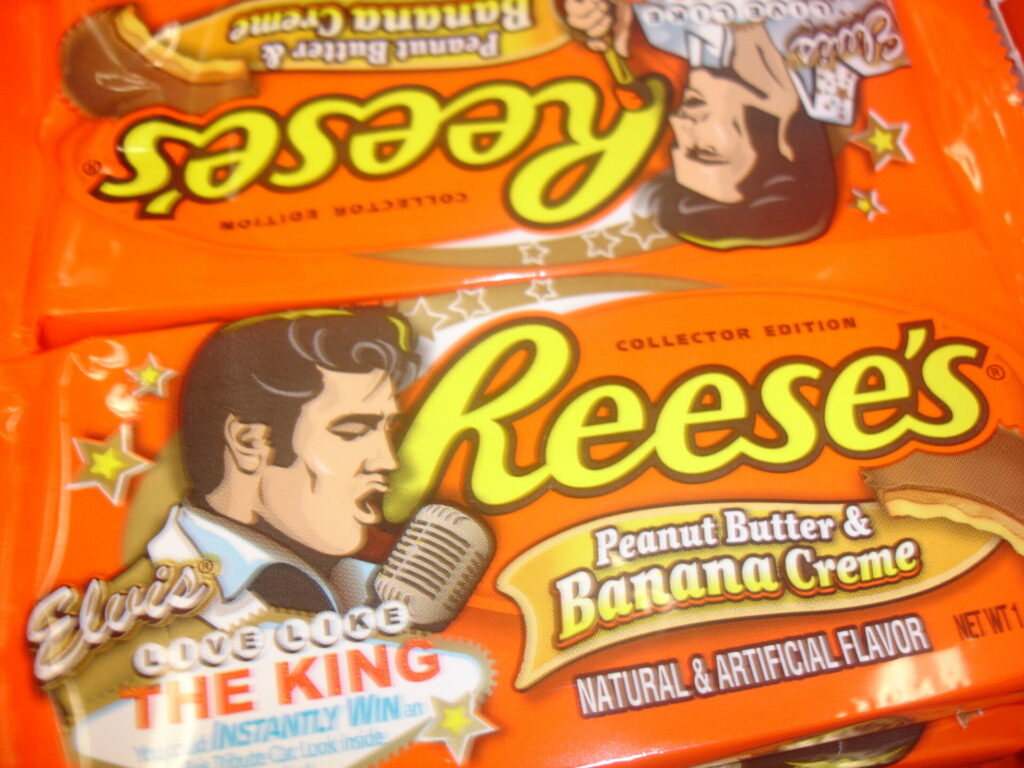
Peanut Butter & Banana Creme Reese’s, by Shawn Rossi (CC BY 2.0)
The Lorette
Never been into peanut butter and jelly jamwiches. But borrowing influences from many sources from Elvis to Indonesia, I have a favourite toast resplendent with peanuty deliciousness. Take pumpernickel toast, slather it with chunky peanut butter, add jalepeno jelly, banana slices, coriander leaves, sriracha drizzles, fresh garlic slivers, generous lime squeezes, and salt. Try it- you won’t believe it.
Maafe
Groundnut stew is made a million ways across Africa, depending on the local flavours and seasonal yields. I’ve had a vegan version on my rotation list since those days, come and gone, a quarter century past. If you simmer carrots, onions, ginger, and garlic and add peanut butter, you’re more or less there already.
But you can go anywhere from there. Maafe is the Senegalese version of peanut butter stew and is all about blending that butter with fatty cuts of meat and spice rubs, a little tomato sauce, piling the stew full of greens and green herbs, then simmering until the whole house smells like heaven.
Improvise along these lines and you can’t go wrong: rub some goat, lamb or beef with your fave pepper stuff, and plenty of chunky fresh ginger and garlic. I’ve never been a minimalist and so would add some combo of paprika, cumin, nutmeg, black pepper, cloves, and various chiles. Marinate for a few hours if you have other things to do.
Chop onions, carrots, more garlic and ginger, green peppers, okra, sweet potato, eggplant, zucchini- whatever veggies you’ve got on hand. Get them started in some butter or use the peanut oil on top of the peanut butter. Add the meat, some bone broth, tomato paste or tomatoes, a few spoons of peanut butter, and later, chopped parsley, cilantro, mint, basil, you name it.
I await your love letters!
Lorette C. Luzajic

